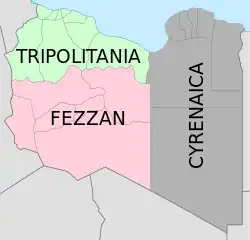1969 Libyan coup attempt
Having taken power in a coup three months earlier, Muammar Gaddafi faced a mutiny by army and interior ministers Moussa Ahmed and Adam Hawaz, both from the eastern Barqa region. The pair were routed and imprisoned in the first of Gaddafi's many survivals.[2][3]
| 1969 Libyan coup attempt | |||||||
|---|---|---|---|---|---|---|---|
| Part of Arab Cold War | |||||||
| |||||||
| Belligerents | |||||||
|
|
| ||||||
| Commanders and leaders | |||||||
|
(Chairman of the Revolutionary Council) |
(Defense Minister) (Interior Minister) | ||||||
| Strength | |||||||
| Unknown | Unknown | ||||||
| Casualties and losses | |||||||
| Unknown | Unknown | ||||||
Aftermath
Defense Minister Lieutenant Colonel Adam al-Hawaz was arrested in December 1969. Despite scant evidence and protests by elders from Cyrenaica, he was sentenced to death in a trial presided by Major Mohammed Najm.[4] The sentence was not carried out and Hawaz remained imprisoned at least until 1984. In March 1988, Hawaz's family was informed of his death but was not given any details.[5]
References
- "Raialyoum". Archived from the original on 2021-07-20. Retrieved 2020-12-29.
- Cooley, John K. (1983). Libyan Sandstorm. London: Sidgwick & Jackson. ISBN 978-0-283-98944-5.
- "Reuters Archive Licensing".
- Times, Raymond H. Anderson Special to The New York (1970-04-11). "New Libyan Regime's Goals Still Unclear". The New York Times. ISSN 0362-4331. Retrieved 2023-06-14.
- "Human Rights Solidarity: Libya" (PDF). Office of the United Nations High Commissioner for Human Rights.
This article is issued from Wikipedia. The text is licensed under Creative Commons - Attribution - Sharealike. Additional terms may apply for the media files.
